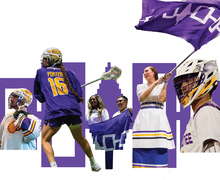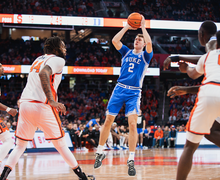Hundreds gather in downtown Syracuse for Women’s March
Bridget Slomian | Presentation Director
Protesters marched from the Everson Museum of Art to the University United Methodist Church.
Hundreds of people, bundled up against the 15 degree cold, gathered in downtown Syracuse on Saturday to participate in the 2019 Women’s March.
Protesters reflected on two years of protest since President Donald Trump’s inauguration. They also spoke on the importance of moving forward with goals of intersectionality within the movement and its activism. The march began at the Everson Museum of Art and ended at the University United Methodist Church.
Some people wore the movement’s iconic pink knit hats and carried signs with feminist messages regarding gender, privilege and education, among other areas of social justice. Intersectionality, a term coined in 1989 by legal scholar Kimberlé Crenshaw, refers to the way different forms of discrimination intersect and have a cumulative impact.
Throughout the march the crowd yelled chants like, ‘No justice, no peace” and “Education is right, not just for the rich and white.”
Nicole Ratliff, a protester, said she was marching to to show “the Trump administration that we’re not going away, and that our rights are not up for grabs, and neither are we.”
Brynn Murphy-Stanley was participating in the event to promote women’s rights, liberation and empowerment, she said. She and her sister, Aydan, have both attended several marches, including the 2017 March for Our Lives.
Regarding any change seen between marches, Aydan said the somewhat large crowd sizes have generally remained the same, but there has been less harassment from counter-protesters.
Ratliff said the women’s movement has grown in intersectionality since the 2017 Women’s March, attributing more activism surrounding racial issues and recent debates about immigration.

Some marchers wore the pink knit hats that became a symbol of the women’s movement after the 2017 Women’s March. Molly Gibbs | Photo Editor
Several cars passed by and honked horns in an expression of support for the movement, with marchers cheering in response.
“It’s healthy and uplifting to see so many people turn out, and especially wonderful to see so many people turn out in spite of the bad weather in upstate New York,” said William Sunderlin, a protester.
At the University United Methodist Church, a rally was held and food was provided. Local leaders gave speeches and performed songs or spoken word poetry on a variety of issues such as racism, xenophobia, climate change, transphobia, ableism and sexual assault. They also spoke on the importance of continually improving one’s activism.
Nada Odeh, the movement’s head organizer, read a personal poem that detailed her experience in 2014 as an immigrant from Syria witnessing racial oppression in the United States.
Black Lives Matter activists Rahzie Seals and LoriKim Alexander reaffirmed the validity of transgender women’s identities as women and encouraged stronger activism. Seals discussed the violence against transgender women, particularly black transgender women, in recent years.
Twenty-seven transgender women were killed in 2018, Seals said. She read the names of the victims out loud, to which the crowd responded with “ashe,” a West African word similar to ‘amen.’
Among other speakers was Common Councilor Joe Driscoll, of the 5th district, who spoke in favor of the community grid option for the Interstate-81 reconstruction. Driscoll criticized the highway’s impact on the 15th Ward in Syracuse, a predominantly black and Jewish neighborhood. Residents were forced to relocate and the neighborhood was destroyed due to the construction, according to The Atlantic.
New York state Senator Rachel May spoke toward the end of the rally. Her speech highlighted climate change and its connection to refugees and immigration.
The final speaker was Nodesia Hernandez. She wore a scarf of the American flag, but said the flag’s colors were red, white and beige, representing the diversity of the nation. She ended the rally by reciting Maya Angelou’s poem “Phenomenal Woman.”
“‘Now you understand, Just why my head’s not bowed.’” Hernandez read. “‘I don’t shout or jump about Or have to talk real loud. When you see me passing, It ought to make you proud.’”

Published on January 20, 2019 at 1:12 pm
Contact Emma: esfolts@syr.edu





